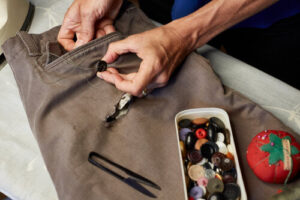
Fixation by Sandra Goldmark (Island Press, 2020)
I’m a fanatic when it comes to fixing things. I’m always gluing, mending, darning, driving nails, sewing, and whatever else it takes to keep my things my things. Call me cheap. Tell me I have a distrust of “new” things. Tell me I’m sentimental (If some thing has been in my family for generations, I’m going to respect it and them by keeping it polished, shined, rolling, slicing and otherwise working.) Tell me I’m narrow-minded. How can it be that others can so easily part with their things — isn’t that why there’s so much seemingly good stuff on NYC’s streets on trash nights? And when, just when, will manufacturers start taking responsibility for their life of their own goods? How can IKEA just keep making stuff that eventually winds up being mauled in a trash truck?
Sandra Goldmark answers a lot of these questions in her new book, “Fixation: How To Have Stuff Without Breaking the Planet” (Island Press, 2020). She’s fueled by intelligence, courage, compassion and optimism. She offers us an eloquently written, insightful understanding of our stuff and a logical solution that we might not get achieve so easily, but it’s worth at least starting towards: building a value chain where good design, reuse, and repair are the status quo, and instilling in each of her readers the inspiration to begin now.
There was much I liked about the book.

Sandra Goldmark, Author, Fixation
Her commitment to finding solutions.
Sandra Goldmark is obviously passionate about repairing things and shares many of the insights and touching stories garnered while working yearound at outdoor pop-up repair tables around NYC with her like-minded and equally skilled husband and growing child. She loses sleep about repair. She’s driven to finding solutions to why things break and why it’s so difficult to get things repaired.
Her insights.
Goldmark knows that understanding the relationship each of us has with our stuff is a key first step to understanding how to address the larger, systemic, challenges. Her hands-on experiences have given her a deep understanding of our, often irrational, reasons for why we own things — and why we don’t want to part with them, even when shinier, new things are within each. Many of us will do anything to get our stuff fixed. Hence, our frustration, and obviously, hers.
She lays the truth on us – that our relationships with our stuff is “more complex than we think”; “even irrational – beyond simple explanation”. Figuring out our relationships to our stuff requires probing our psyches, our identities, our sense of who we are. She notes, “…the objects were simply telling us, quite clearly, about each woman’s home, her story, and the particular stuff culture she lived in. Those objects, and the thousands of others we fixed, had something to say.”
I especially liked her insights into what it takes to repair objects when making her case for society to invest in training. Goldmark first reminds us “It’s not all so easily demonstrated in a You Tube video.” She goes on, “Repair – as well as theatre – requires creativity, making unusual connections, and learning from disparate experiences,” and goes on to describe touching moments when she or her husband brilliantly tackled chairs, bears and other items that, of course, came with no repair manual.
Her eloquence.
I expected lots of nuts and bolts, like I do from most trade books, but, instead, I learned from a wealth of examples and analogies from the likes of anthropologists like Ian Hodder and Daniel Miller, the clothing historian Robert Ross, food advocate Michael Pollan, and economist Richard Heinberg, author of “The End of Growth.”
Her courage.
Knowledging an entire system that needs repair, Goldmark is not afraid to criticize the status quo, or to challenge our biggest and most popular brands, or her readers, who of course are buying the stuff.

Everyone should learn to sew.
She posits forthrightly that “…perhaps it is a society that makes it impossible for people to keep their stuff in good working order that should be labeled irrational”.
Goldmark points out the inconsistencies among two key manufacturers who may be contributing the most to our throwaway society when she asserts that, “Apple has prioritized certain aspects of design, especially newness and aesthetic appeal over others like longevity, accessibility, and modularity.” She challenges industry to invent more ethical business models: “…until companies like IKEA begin to see multiple sources of revenue in their products beyond the first purchase, a truly healthier relationship with our stuff — as a society and as individuals— will remain elusive”.
She challenges her readers to step up: “ If we’re not buying used ourselves, then we’re just outsourcing the responsibility of ‘closing the loop’ rather than accepting ownership of that responsibility along with ownership of our stuff.” Fairly, she has provided many examples of what she herself does already.
Her Optimism.
Maybe she’s a little too optimistic, but Goldmark’s analysis of the entire system that she maintains, rightly, but be redesigned, starting with people’s own behavior and psychology, compounded by entrenched business models associated with selling stuff – and more stuff, and her frank admission that solutions are not so easy… for instance, It’s not so easy as passing a Right To Repair law, or making it economically easy for repair shops to exist once again, make complete sense, and give us much to chew on, in at least starting down the path towards making change at the policy level, the practical levels of design and manufacturing methods, as well as those relating to our personal choices. I was inspired to do even more in my own life, and I’m sure other readers will be too.
Posting Guideline – Stories published on WeHateToWaste.com are intended to prompt productive conversations about practical solutions for preventing waste. Please issue your comments accordingly. Opinions expressed are solely those of the contributors and implies no endorsement by WeHateToWaste.com.

Great article! It really is unfortunate how little we learn about practical repair skills in schools now, despite how important they are to have on a financial and environmental level. There’s definitely a lot to say as well, about the ways too many companies make it nearly impossible to repair their products to get consumers to keep buying newer models. I wonder how much consumer/legal pressure could help bring about change in that department.
This article made me think about the amount of products that are thrown in the trash that could easily be fixed in less than five minutes. Encouraging individuals to pick up fixation skills would not just benefit the environment but also themselves! People get to save money and feel accomplished when they make a product as good as new. I agree that there does need to be change within policy and the general structure of society regarding repairs but for now its great to get people involved in fixing things themselves.
I had never heard of this book before- but I’m glad I have now. Throughout the article I found myself reflecting on the frequency at which I dispose of items rather than trying to salvage them- and it’s definitely more often than I thought. So many products on the market are advertised as seasonal–from trendy clothing to holiday decor–and once we no longer have use for these items, we just get rid of it. I wonder how much of what I’ve mindlessly thrown out can be repurposed or mended with a quick fix. This summer would be an excellent time to find out!
I also have a hard time getting rid of my things and form such irrational attachments to them. I find it so intriguing how Goldmark is able to discuss human behavior like my own and juxtapose it with how large companies operate. Although I had never heard of this book before, I’d really like to read it now and learn more about how our current society interacts with our stuff. Maybe with more public education, the solutions Goldmark proposes in her book about repairing this broken system will become more feasible!